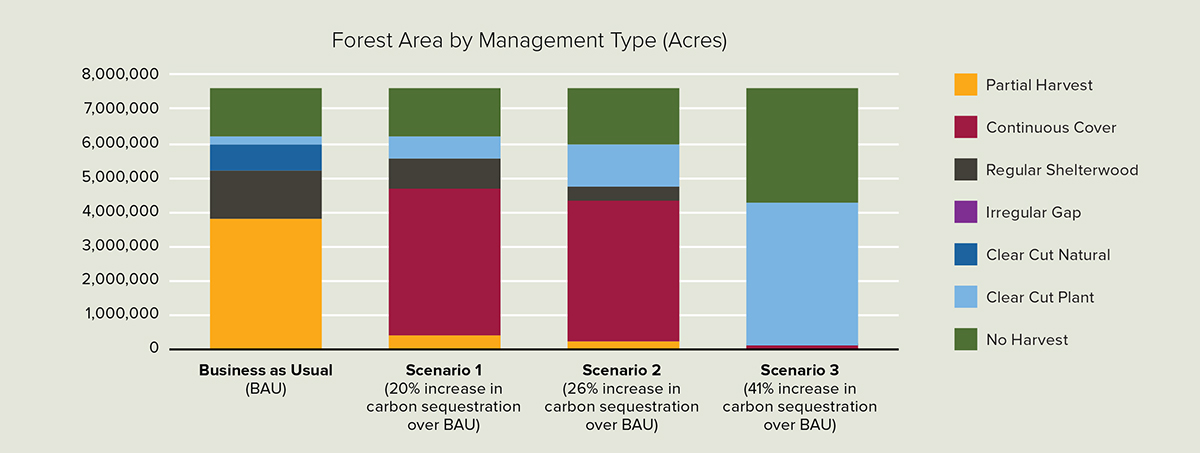Thanks to national and international climate research and an understanding of our region’s woods, New England Forestry Foundation (NEFF) has long known improved, climate-smart forest management in New England had an important part to play in solving the climate crisis. Now, we not only have the necessary science to back that knowledge up, but we’re also producing some of the science ourselves.
In November 2022, NEFF published an article in the peer-reviewed journal Forests that demonstrated implementing our own Acadian Forest Exemplary Forestry standards in New England could increase carbon storage by an estimated 488 million metric tons of CO2 equivalent—equal to about 23 percent of the emissions reductions needed for New England to reach net-zero emissions by 2050. NEFF’s conclusions were supported by an October 2022 report from Highstead and coauthors like Harvard Forest, which studied the projected carbon impacts of improved forestry and other forest-related mitigation approaches across New England.
Most recently, the Forest Carbon for Commercial Landowners (FCCL) Initiative released a report in March stating northern Maine’s commercial forestlands could store at least 20 percent more carbon each year by changing forest management practices, and without reducing harvest levels.
These studies have a cumulative effect—as each one is published, the case for Exemplary Forestry, NEFF’s 30 Percent Solution, and climate-smart forestry in New England grows stronger.
NEFF’s First Peer-Reviewed Publication
NEFF has reached an exciting milestone with the publication of its first original research paper in a peer-reviewed scientific journal. The article in Forests, “Storing More Carbon by Improving Forest Management in the Acadian Forest of New England, USA,” determined the climate benefits of switching from conventional forest management to Exemplary Forestry.
This means NEFF’s modeling of the carbon benefits of Exemplary Forestry in the Acadian Forest has passed scientific muster. These benefits make up the bulk of the carbon savings in NEFF’s 30 Percent Solution, which demonstrates that combining four forest-based climate solutions can provide nearly one-third of the CO2 emissions reductions New England needs in the next 30 years. We have received confirmation from the wider field of forestry and forest ecology that Exemplary Forestry is just as powerful a tool as we believed it to be.
The paper first studied carbon impacts across a four-million-acre region of northwestern Maine, and then applied those results across all of New England’s Acadian Forest—which encompasses large areas of Maine, New Hampshire and Vermont, as well as small portions of western Massachusetts and Connecticut—and went on to determine that New England’s Acadian Forest could store the aforementioned additional 488 metric tons of CO2e in the forest under Exemplary Forestry management if applied to all private timberland in understocked counties.
Exemplary Forestry can produce healthier forests with more valuable timber over the long term. However, for it to spread widely among private landowners, it must be financially feasible in the short term, as well. Financial modeling conducted for this study showed that a combination of revenue streams from timber management, sales of carbon credits, and philanthropic funding of conservation easements can make Exemplary Forestry profitable over a 15-year time frame.
Now that NEFF has its academic foot in the door, our science team will look to submit additional articles about Exemplary Forestry to other journals, as well as publish already-underway studies on different topics.
NEFF publishing its first peer-reviewed paper is truly a momentous occasion, so raise a glass and toast to Alec Giffen, lead author and NEFF Senior Forest Science and Policy Fellow; Colleen Ryan, coauthor and NEFF Forest Scientist; and the article’s coauthors at other organizations. Cheers! Read the article.
Forests Article Coauthors
Alec Giffen, Senior Forest Science and Policy Fellow for New England Forestry Foundation
Colleen Ryan, Forest Scientist for New England Forestry Foundation
Ethan Belair, Natural Climate Solutions Forester for The Nature Conservancy
Mike Pounch, now Chief of Silviculture for Maine Bureau of Parks and Lands
Seth Brown, Vice President, Forestry and Land Use for Quantified Ventures
Highstead Climate Report
Highstead’s report, New England’s Climate Imperative: Our Forests as a Natural Climate Solution, models the impact of five integrated climate-mitigation pathways: avoided deforestation, wildland reserves, improved forest management, mass timber construction, and urban and suburban forests. Of these approaches, improved forest management has by far the greatest potential to mitigate climate change.
While the modelled carbon performance of well-managed woodlands in the report is impressive and dovetails with NEFF’s work, NEFF also remains committed to all five pathways and believes they should be addressed together using a systems approach. Not only will treating the pathways as one integrated system allow the region to make the greatest possible carbon-storage gains, but it will also allow us to preserve everything that makes forests a vital part of life in New England.
Highstead estimates New England could store 184 million metric tons of CO2e over 30 years if improved forest management was implemented on half of the region’s understocked working forestland. NEFF estimates New England could store 542 million metric tons of CO2e in the same timeframe if its Exemplary Forestry standards were implemented across all understocked counties in the region.
At a per-acre level, NEFF and Highstead’s results are similar, but Highstead’s total is lower because the organization chose to anticipate a 50 percent adoption rate.
“Highstead’s analysis is in line with the modeling work NEFF has been conducting for several years, in spite of using different methods and different targets,” said NEFF’s Alec Giffen, a report coauthor along with NEFF Executive Director Bob Perschel and NEFF Deputy Director and Climate Fellow Andrea Colnes. “Instead of setting a target for implementing improved forest management on a portion of the landscape, we reported the total potential across all understocked counties in New England to emphasize the whole opportunity that’s available if the region chooses to make natural climate solutions a priority.”
In this instance, a partner organization—whose work was extensively reviewed by other experts—rather than the peer-review process has provided NEFF with verification of our Exemplary Forestry numbers, as well as confirmed our sweeping 30 Percent Solution is backed up by solid science, and we look forward to building off of these studies’ findings together. Learn more.
Forest Carbon for Commercial Landowners
A unique coalition of New England scientists, economists, large commercial forest landowners, and environmental nonprofits called the Forest Carbon for Commercial Landowners (FCCL) Initiative commissioned a study from the University of Maine in 2021 to discover whether it was possible to increase carbon storage on commercial lands by changing forestry practices, and, if so, how much it might cost to incentivize landowners to switch to climate-aligned practices.
The University of Maine modelled the results of seven different land management practices—including leaving land unharvested—across a study area of 7.6 million acres over a 60-year period. Maine’s actual commercial forestlands total approximately 10 million acres.
The results are now in, and the study area’s forestlands could store at least 20 percent more carbon each year without reducing harvest levels.
“Given the scale of Maine’s commercial forests, it would be hugely beneficial if we put them to work in the fight against climate change while simultaneously improving wildlife habitat and making timber management more profitable in the long-term,” said NEFF’s Giffen, a coauthor of the report. “The study shows these lands can store more carbon, and researchers have also determined incentive rates that can work for landowners and are more affordable than other standard approaches to reducing carbon emissions.”

The researchers didn’t make assumptions about which forestry practices would perform best, and simply modelled established approaches, thereby allowing the model to select the “optimum” approach for carbon sequestration. The study compared three possible scenarios to “business-as-usual” management to ensure any carbon sequestration benefits from improved management were truly “additional” (above what would occur under business-as-usual).
The report’s two feasible, successful scenarios involve maintaining or raising clearcutting levels from business as usual (researchers included a third scenario only to show the theoretical maximum amount of sequestration that could be achieved while still producing current levels of wood; the FCCL collaboration does not suggest it is feasible to implement). However, as the report acknowledges, carbon capture should not be the only priority considered when deciding how to manage forests.
NEFF believes it is crucial to recognize there are tradeoffs among carbon capture, increased production of climate-smart products, and protection of wildlife habitat and biodiversity—and the FCCL’s modeled scenarios are not intended to optimize for all of these values. NEFF advocates for using a systems approach to address these multiple interacting values, and such modeling studies offer a fresh look at what is possible. NEFF’s science team looks forward to doing more of them and sharing their results until we fine tune the approach for northern Maine’s commercial forestlands.
While there’s more to be done to further the FCCL Initiative’s work, the FCCL report has accomplished something remarkable: it has proven that specific combinations of forestry approaches can have carbon benefits on commercial lands while still maintaining harvest levels, thereby making it possible for millions more acres to fully join the fight against climate change without negatively impacting rural Maine communities or contributing to leakage.
What sets this report apart is that it addresses head-on two major issues that beset other proposals for increasing forest carbon: additionality and leakage. To be valuable, gains in carbon storage must be truly additional to what would have happened in the absence of the proposed action. FCCL addresses this issue by comparing improved forest management to business-as-usual management. Leakage is the spillover of in-forest carbon sequestration gains and losses from one economic market to another, given that the wood products we all use have to come from somewhere. If the United States or a region in the U.S. reduced the amount of wood it produced, any progress we claimed to make in reducing global atmospheric CO2 levels by storing more carbon in our unharvested trees could, in practice, be eclipsed by CO2 emissions from other forestry markets that increased harvesting to meet our unchanged demand for wood products. Since the FCCL analysis holds harvest levels constant across its modelled scenarios, there is no potential for leakage.
FCCL Next Steps
The report calls for more research and policy work, in part because of limitations in some of the modelling—and the very practical need to set up a system of landowner incentives. The carbon sequestration benefits of irregular gap forestry, the system included in the modelling that’s most like Exemplary Forestry, are likely understated in the study due to modeling limitations, so NEFF’s forestry and science teams are looking forward to determining its true potential through future research.
Even with the current modelling limitations, irregular gap forestry increased carbon storage by 15 percent in the FCCL study, which means it may be competitive with the current top-performers with more nuanced modeling.
NEFF believes Exemplary Forestry represents the best approach for addressing climate change through forestry because it considers not just timber and carbon, but also the whole array of forest values, including biodiversity, recreational opportunities and ecosystem services.
View and download the full FCCL report and read a science highlights blog post featuring a summary of the report’s methods, findings, and next steps.
Putting The Science to Work
Though the FCCL study, NEFF’s Forests article and Highstead’s report were regional research undertakings, they offer solutions that address climate change at a global level by studying scenarios and making recommendations that lead to real reductions in atmospheric CO2 levels by accounting for leakage and additionality.
NEFF will use these reliable studies to shape its new Climate-Smart Commodities Partnership project. The USDA has awarded $30 million to NEFF and its partners to help forest landowners implement climate-smart forest practices that also protect ecosystem health and biodiversity, and we now have trustworthy, homegrown science to serve as our road map.


